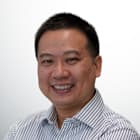Commentary: What Singapore can do to make the one ‘principal doctor’ model work
Better coordinated hospital care across specialties makes sense for an ageing population, but the devil will be in the details, says public health doctor Jeremy Lim.

Healthcare worker advising a patient. (Photo: iStock)

This audio is generated by an AI tool.
SINGAPORE: Someone who falls and sustains a hip fracture would typically be admitted under the care of the orthopaedic surgeon, as the specialist in the most acute clinical issue. Say the patient also has diabetes, high blood pressure and felt disorientated before the fall, the surgeon would then bring in an endocrinologist, a cardiologist and a neurologist for input.
But such patients with complex or multiple medical conditions can end up with fragmented care, confused and wondering: Who really is in charge of their care?
Specialists tended to focus on their own organ or disease. As Health Minister Ong Ye Kung put it, patients and caregivers have to repeat their symptoms to each specialist, get prescribed multiple treatments and medications, and end up “trying to make sense of them all” themselves. In a major reform of the public hospital care teams, Mr Ong announced in September that patients will see one “principal doctor” who can integrate care across specialties.
The healthcare needs of Singapore’s ageing population have changed. The obesity rate has risen significantly to about one in eight adults, according to the latest National Population Health Study. The prevalence of chronic diseases remains high and there is a growing concern that more are getting heart problems, strokes and dementia at a younger age.
For coordinated and integrated care, this latest approach consolidates care under a doctor with broad knowledge across multiple specialties. This would be a better way than requiring specialists with already heavy loads to pursue more expertise and competencies outside their chosen specialties (though experienced specialists who have gained such skills can also play the role of the principal doctor).
To achieve this, Mr Ong said that the public healthcare system will develop more hospital clinicians with broad-based competencies by design.
Mr Ong’s diagnosis of the inadequacies of the current model is correct. Many of my fellow doctors agree with his proposed treatment plan.
However, change is always hard. The implementation challenges are not trivial, especially when these changes affect professional identity, roles and responsibilities and potentially income. There are three categories of issues that need to be decisively addressed for a successful transformation.
MANAGING OVERLAPS AND ADDRESSING AMBIGUITIES
First, let’s be realistic – there are “turf issues” in medicine. Doctors have all occasionally seen sharp elbows when specialties overlap and compete for patients, especially in private care.
Both general surgeons and gastroenterologists can perform gastrointestinal endoscopies. Both vascular surgeons and interventional radiologists can justifiably lay claim to endovascular procedures, such as angioplasties and stent placements. A hospital clinician would have the unenviable task of choosing between different doctors and across specialties.
What happens if there is disagreement on the “best” clinical intervention between the hospital clinician and the specialist, or between two specialists and the hospital clinician sandwiched in between?
If the patient has a kidney condition, but the treatment proposed by the kidney specialist risks damage to the heart, while another treatment option preferred by the cardiologist has a much lower success rate, which specialist voice takes precedence? If either option chosen by the hospital clinician resulted in worse-than-anticipated damage, whose is the responsibility and the liability?
It follows that medico-legal liability will also need to be resolved. “Peer professional opinion” is often used as a standard to assess appropriateness of practice. What is the “standard” for the hospital clinician vis-a-vis the specialist?
Singapore’s healthcare system already deploys resident physicians, who are non-specialists providing care under the supervision of specialists. The legal position is clearer here: Resident physicians are pegged as performing at the general practitioner (GP) level and will not be assessed as specialists. For hospital clinicians, a whole body of case law would have to develop but the Ministry of Health can accelerate this with clear policies around accountability and liability.
PAY AND INCENTIVES
Second, incentives matter and shape doctors’ choices of post-graduate training. It is encouraging that the authorities have already assured that career paths and compensation will be enhanced and made commensurate with other doctors.
The details will be important. Specialists earn very different incomes depending on specialty and even some sub-specialties have far higher earning potential. Where would the broad-based hospital clinician be pegged?
A 2023 commentary by Alexandra Hospital doctors published in the Annals of the Academy of Medicine Singapore wryly noted that despite Internal Medicine specialist training being the most ideal for general medical coverage of multi-condition patients (probably the closest in today’s context to the hospital clinician), only a smattering of doctors is so accredited. The Singapore Medical Council's latest report documents only 326 of Singapore’s 17,326 medical practitioners (on full and conditional registration) were Internal Medicine-accredited.
Morale and job satisfaction challenges are the likely factors here. Anecdotally, my fellow doctors tell me Internal Medicine training is tough and the practice even tougher in part due to tension and inadequate communication with organ-specific specialists.
PUBLIC ENGAGEMENT
Finally, the public is used to the notion of the specialist as the “dua lo kun”. The assumption that the “big doctor” (in Hokkien) knows everything and has the wherewithal to integrate all the different considerations is implicit but sadly unrealistic as Singapore becomes super-aged.
That said, the hospital clinician may be deliberately trained to have the competency but this is contingent on building up public trust in and credibility of the hospital clinician. The public has to be convinced that the hospital clinician model is a superior way to organise inpatient care – not an off-loading measure to save specialists’ time, not a cost-cutting intervention.
It is also critical to avoid, at all costs, the misconception that public healthcare minimises access to specialist care and thus pushes patients to private sector care.
MAKING IT WORK FOR SINGAPORE
In the last two decades, Singapore has very intentionally uplifted the role of the family physician through greater funding, higher training requirements and showcasing their value repeatedly to the medical community and the public. Today, the standing of family physicians - as experts in their own right and as a pillar for preventive and primary care in the community - is much more firmly established.
Doing likewise for the hospital clinician will be needed. It will take many years and campaigns, as well as a demonstrable foundation of data and studies that hospital clinicians do indeed improve care in Singapore. Research conducted overseas suggests patients had shorter hospital stays and lower costs for comparable clinical quality of care.
These challenges should not dishearten would-be reformers. The fundamental realities facing Singapore and every ageing nation will not disappear: Elderly patients with multiple interacting complex conditions will be the norm. For efficiency and cost considerations, better integration will be necessary. Singapore has no choice but to make this work.
Dr Jeremy Lim is a public health specialist and author of Myth or Magic – The Singapore Healthcare System.


















